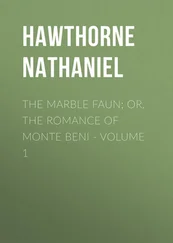Such was the position in which we find Miriam some few months after her establishment at Rome. It must be added, however, that the world did not permit her to hide her antecedents without making her the subject of a good deal of conjecture; as was natural enough, considering the abundance of her personal charms, and the degree of notice that she attracted as an artist. There were many stories about Miriam’s origin and previous life, some of which had a very probable air, while others were evidently wild and romantic fables. We cite a few, leaving the reader to designate them either under the probable or the romantic head.
It was said, for example, that Miriam was the daughter and heiress of a great Jewish banker (an idea perhaps suggested by a certain rich Oriental character in her face), and had fled from her paternal home to escape a union with a cousin, the heir of another of that golden brotherhood; the object being to retain their vast accumulation of wealth within the family. Another story hinted that she was a German princess, whom, for reasons of state, it was proposed to give in marriage either to a decrepit sovereign, or a prince still in his cradle. According to a third statement, she was the offspring of a Southern American planter, who had given her an elaborate education and endowed her with his wealth; but the one burning drop of African blood in her veins so affected her with a sense of ignominy, that she relinquished all and fled her country. By still another account she was the lady of an English nobleman; and, out of mere love and honor of art, had thrown aside the splendor of her rank, and come to seek a subsistence by her pencil in a Roman studio.
In all the above cases, the fable seemed to be instigated by the large and bounteous impression which Miriam invariably made, as if necessity and she could have nothing to do with one another. Whatever deprivations she underwent must needs be voluntary. But there were other surmises, taking such a commonplace view as that Miriam was the daughter of a merchant or financier, who had been ruined in a great commercial crisis; and, possessing a taste for art, she had attempted to support herself by the pencil, in preference to the alternative of going out as governess.
Be these things how they might, Miriam, fair as she looked, was plucked up out of a mystery, and had its roots still clinging to her. She was a beautiful and attractive woman, but based, as it were, upon a cloud, and all surrounded with misty substance; so that the result was to render her sprite-like in her most ordinary manifestations. This was the case even in respect to Kenyon and Hilda, her especial friends. But such was the effect of Miriam’s natural language, her generosity, kindliness, and native truth of character, that these two received her as a dear friend into their hearts, taking her good qualities as evident and genuine, and never imagining that what was hidden must be therefore evil.
We now proceed with our narrative.
The same party of friends, whom we have seen at the sculpture-gallery of the Capitol, chanced to have gone together, some months before, to the catacomb of St. Calixtus. They went joyously down into that vast tomb, and wandered by torchlight through a sort of dream, in which reminiscences of church aisles and grimy cellars — and chiefly the latter — seemed to be broken into fragments, and hopelessly intermingled. The intricate passages along which they followed their guide had been hewn, in some forgotten age, out of a dark-red, crumbly stone. On either side were horizontal niches, where, if they held their torches closely, the shape of a human body was discernible in white ashes, into which the entire mortality of a man or woman had resolved itself. Among all this extinct dust, there might perchance be a thigh-bone, which crumbled at a touch; or possibly a skull, grinning at its own wretched plight, as is the ugly and empty habit of the thing.
Sometimes their gloomy pathway tended upward, so that, through a crevice, a little daylight glimmered down upon them, or even a streak of sunshine peeped into a burial niche; then again, they went downward by gradual descent, or by abrupt, rudely hewn steps, into deeper and deeper recesses of the earth. Here and there the narrow and tortuous passages widened somewhat, developing themselves into small chapels; — which once, no doubt, had been adorned with marble-work and lighted with ever-burning lamps and tapers. All such illumination and ornament, however, had long since been extinguished and stript away; except, indeed, that the low roofs of a few of these ancient sites of worship were covered with dingy stucco, and frescoed with scriptural scenes and subjects, in the dreariest stage of ruin.
In one such chapel, the guide showed them a low arch, beneath which the body of St. Cecilia had been buried after her martyrdom, and where it lay till a sculptor saw it, and rendered it forever beautiful in marble.
In a similar spot they found two sarcophagi, one containing a skeleton, and the other a shrivelled body, which still wore the garments of its former lifetime.
“How dismal all this is!” said Hilda, shuddering. “I do not know why we came here, nor why we should stay a moment longer.”
“I hate it all!” cried Donatello with peculiar energy. “Dear friends, let us hasten back into the blessed daylight!”
From the first, Donatello had shown little fancy for the expedition; for, like most Italians, and in especial accordance with the law of his own simple and physically happy nature, this young man had an infinite repugnance to graves and skulls, and to all that ghastliness which the Gothic mind loves to associate with the idea of death. He shuddered, and looked fearfully round, drawing nearer to Miriam, whose attractive influence alone had enticed him into that gloomy region.
“What a child you are, poor Donatello!” she observed, with the freedom which she always used towards him. “You are afraid of ghosts!”
“Yes, signorina; terribly afraid!” said the truthful Donatello.
“I also believe in ghosts,” answered Miriam, “and could tremble at them, in a suitable place. But these sepulchres are so old, and these skulls and white ashes so very dry, that methinks they have ceased to be haunted. The most awful idea connected with the catacombs is their interminable extent, and the possibility of going astray into this labyrinth of darkness, which broods around the little glimmer of our tapers.”
“Has any one ever been lost here?” asked Kenyon of the guide.
“Surely, signor; one, no longer ago than my father’s time,” said the guide; and he added, with the air of a man who believed what he was telling, “but the first that went astray here was a pagan of old Rome, who hid himself in order to spy out and betray the blessed saints, who then dwelt and worshipped in these dismal places. You have heard the story, signor? A miracle was wrought upon the accursed one; and, ever since (for fifteen centuries at least), he has been groping in the darkness, seeking his way out of the catacomb.”
“Has he ever been seen?” asked Hilda, who had great and tremulous faith in marvels of this kind.
“These eyes of mine never beheld him, signorina; the saints forbid!” answered the guide. “But it is well known that he watches near parties that come into the catacomb, especially if they be heretics, hoping to lead some straggler astray. What this lost wretch pines for, almost as much as for the blessed sunshine, is a companion to be miserable with him.”
“Such an intense desire for sympathy indicates something amiable in the poor fellow, at all events,” observed Kenyon.
They had now reached a larger chapel than those heretofore seen; it was of a circular shape, and, though hewn out of the solid mass of red sandstone, had pillars, and a carved roof, and other tokens of a regular architectural design. Nevertheless, considered as a church, it was exceedingly minute, being scarcely twice a man’s stature in height, and only two or three paces from wall to wall; and while their collected torches illuminated this one small, consecrated spot, the great darkness spread all round it, like that immenser mystery which envelops our little life, and into which friends vanish from us, one by one. “Why, where is Miriam?” cried Hilda. The party gazed hurriedly from face to face, and became aware that one of their party had vanished into the great darkness, even while they were shuddering at the remote possibility of such a misfortune.
Читать дальше












